Kurenevckaya tragedy
 Bashny.Net
Bashny.Net
Fifty years ago, on March 13, 1961 in Kiev, there was a man-made disaster, which killed, according to various estimates, the life of one and a half to two thousand people.
Within minutes the area (over thirty hectares) proved
a multimeter layer of sand, pellets, mud and clay. Dozens of buildings were destroyed, and the main thing - killed hundreds of people! From fallen power poles lit up a crowded (the notorious rush hour!) Bus, trolley bus, tram. Man-made elements have become hostages of the drivers
trucks, passengers of cars, pedestrians and onlookers just ...
What happened?
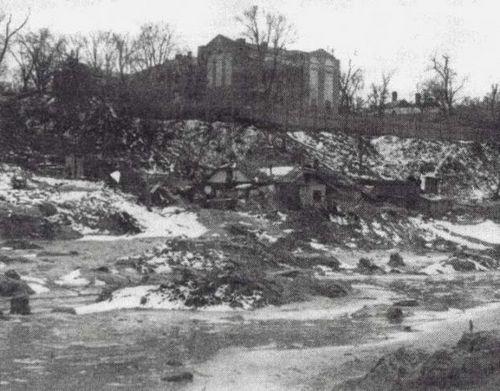
1961. Soviet man first flew in space. Kiev scientists headed by Academician Glushko launches the first electronic computer machine in Europe, the predecessor of the modern computer. Kiev "Dinamo" becomes champion of the USSR.
Several thousand families celebrated the housewarming. Kiev is growing strongly. There are new housing estates. In the capital, the construction is in full swing. The country needs a brick. Many brick. The plant operates in three shifts, in order to implement the plan and to bring happiness to the people of Kiev brand new "Khrushchev."

Monday 13th began as an ordinary spring day. Kievans rush to work in time to perform their civic duty and increase the achievements of socialism. "Humpback" buses could hardly cope with the large number of passengers.

Suddenly, a small stream of water paralyzed traffic in the area Kurenivka. Suddenly, a small stream instantly turned into a huge avalanche of gray-brown color. It swept away everything in its path: cars, houses, people. At this point, someone called in a phone booth, and he was killed with a pipe in his hand. Someone just sat down for breakfast, and died for the dinner table. Someone managed to survive in spite of death. Some survivors of the fateful date of March 13 is still pursuing.
Way pulp by St. Cyril's Church
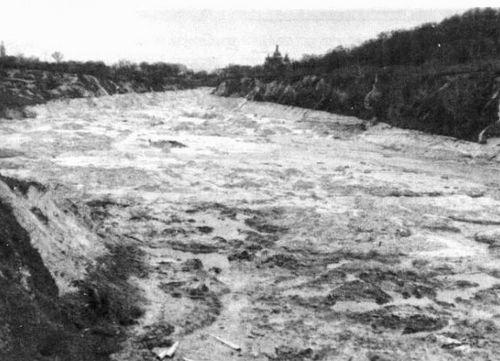
In the area of Babi Yar dam burst, followed by more than 10 years produces hydraulic alluviation with Peter's brick plants. The dam began to break down in the early morning. At 6:45, after 3, 5 o'clock it burst. Mud shaft ran through the streets of the district Kurenivka demolishing buildings, people, corpses and coffins with the remains of the nearby cemetery. Gradually rural dispersed up to 60-70 km / h. The flood lasted only half an hour, but the consequences were disastrous.
Area flooded pulp Kurenevka.
In the foreground - the stadium «Spartak»,
further - building on Frunze Street and the depot Krasin. 1961
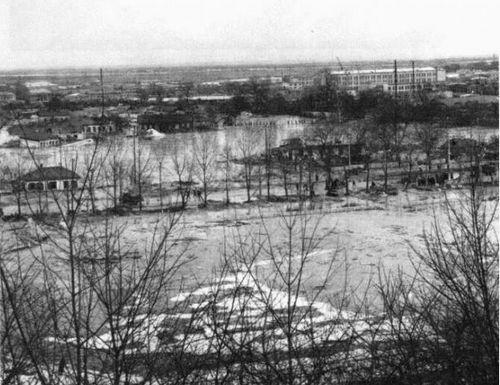
Under the blow fell the tram depot. Krasin (nowadays carbs "hem"), the plant "Ukrpromkonstruktor", hospital, stadium "Spartak", part of the street. Frunze, housing and in the ravine below. Due to the short-circuit ignited transport people amazed shock. Several employees of the depot sacrificed their lives, but disconnect the power substation - otherwise the consequences could be even worse.
Kindergarten and homes
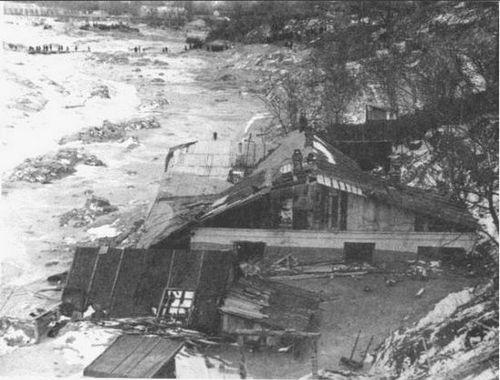
The height of the tree in the street Frunze halved, but it was enough to have killed hundreds of people. Rasteksheysya pulp became as hard as stone. Bordering fence with Podolski descent stadium "Spartak" was flooded with a layer of mud and clay so that its high fence was not visible, it was flooded carbs. Building hospitals Podolsk resist. Some of the patients escaped from the flood on its roof.
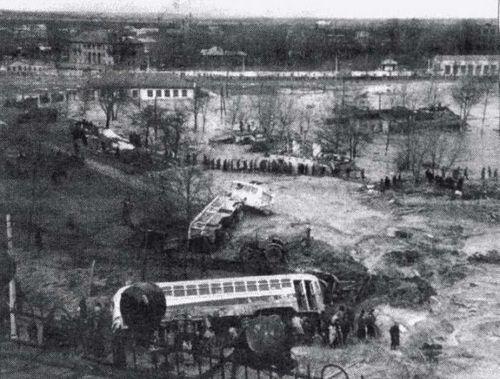
Where it all began:
The first step to disaster Kiev made March 28, 1950, when the Executive Committee of the Kiev city council made the decision №582.
This decision would approve the design and organization of gidrootvalov spurs in Babi Yar, with the filing of the Ministry of construction materials prepared by the Moscow Trust jetting. But the decision of the executive committee №2405 some changes made: for example, the reclamation has been raised to the very edge of the ravine!

Earlier this place was a sand pit. Work on filling the ravine began in 1952, surrounded by earthen dams space dredge began pumping pulp - with places for the development of Peter clay brick factories. The height of the protective dam was ten meters lower safety standards. But, above all, a former quarry filled at a height of sixty meters above the large residential and industrial district of Kiev ...
Filled pulp headwaters ravine between the current streets Olzhych and Melnikov.
On the left side of the frame - a pumping station (hereinafter - March 1961)

Not very successful project "dobilo" interference of officials amateurs ...
So, the project gidronamyva been "finalized". Underestimated the water content of rocks ravine. It does not take into account the likelihood of a snowy winter. The concrete dam was replaced by zemlyanye.Iz savings to reduce the diameter of drainage pipes, which ultimately did not allow the water to escape, leaving the soil brought. Brick plants, exceeded the plan, working in three shifts -, respectively, and the amount of pulp became three times the estimated income. And to top it all - to alarms went unanswered.

Then, in 1961, in the ravine it has accumulated almost four million cubic meters of liquid slurry Peter's brick plants. In this way the city government, led since 1947 by Alexey Davydov, sought to kill several birds with one stone: to establish smooth, room, industrial production of bricks, so necessary in the construction of numerous residential areas, create a convenient traffic between raw and Kurenyovka (street Olena Teligi) and simultaneously eliminate Babi Yar, breaking in the best Soviet traditions in its place the city recreation park with binding attractions, stadiums and restaurant complex.
The mouth of the debris flow (at the top of the dike scour)

Glushchenko, head of Inspection Podolsk district, reports the February 11, 1957 the head of the Kiev branch of jetting Tsipenyuk and director of the plant Petrovsky brick factories Braz: "due to lack of supervision by your employees, ditch Babi Yar is always in poor condition, especially during the winter. The ditch is filled, and water together with sand overflows its banks and floods the surrounding areas of enterprises and organizations ».
But alarm condition "ditch Babi Yar", no one responded. In early March 1961, concern began to beat Kiev simple: they saw streams flowing on Dams. But the authorities are not troubled until the very moment of the tragedy.
Destroyed lower dam

The tragedy, when suddenly a huge mass of pulp broke through an earthen dam and at a speed of five meters per second at a height of four-storey house rushed down to the Kurenevka, sweeping wave of his all life, hope never happen again. Avalanche wet soil volume of 700 thousand. Cubic meters of width of about 20 meters and a height of about 14 m slid along the ravine and rolled down the street. Frunze, smashing everything in its path. 34 one-, two-storey houses 5, 2 dorm, 12 single-storey houses of the state fund. The total area of these buildings was five thousand square meters, overturned buses and trolley buses, tram depot destroyed them. Krasin, the stadium "Spartak" - is "mining" elements. 25 hectares were under the 3-meter layer of pulp. The exact number of victims is so still and unknown - officially announced the 145 victims. However, according to eyewitnesses, the number of those killed in the crash much more - about 2 thousand.
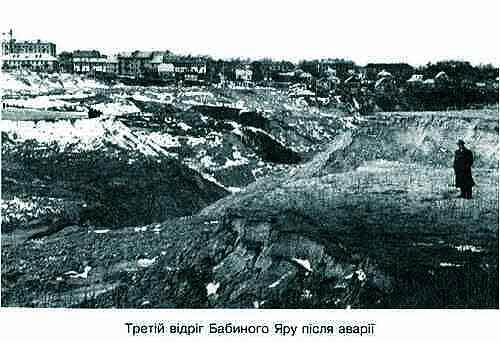
Damaged pilot plant "Ukrpromkonstruktor" overhauls the Office of City Council, energy management "Kyivenergo", rail welding plant №5 South-Western Railway. That's nearly 9, 000 square meters. The total area flooded pulp amounted to more than 30, 000 square meters.
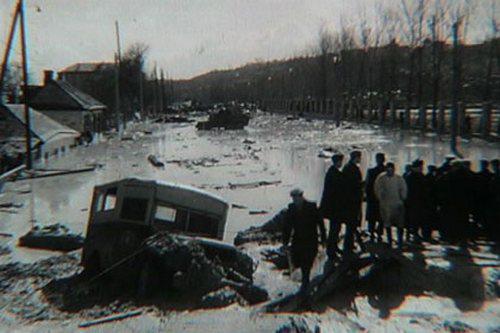
This tragedy has destroyed seven tram, trolleybus and bus passengers, three enterprises of the region, has killed hundreds of people of Kiev - as the employees of these companies, and passengers who were traveling to work in other areas, residents of dormitories, a large private sector, military and firefighters, policemen doctors, patients clinic №15, drivers and passengers of vehicles - we know of two nonfiction books and memoirs of eyewitnesses.

They say the archives
"... In 8 hours 30 minutes in the morning in a good effort levee, which was built for the production of zamyva Babi Yar, water and soil liquefaction was flooded part of the territory adjacent to the street to them. Frunze near the tram depot. By 10 am the flow of water has stopped. As a result of the flooding destroyed 68 residential and 13 office and industrial buildings. Given in disrepair 298 residential apartments, including 163 in private households, inhabited by 353 families with a total of 1228 people ...
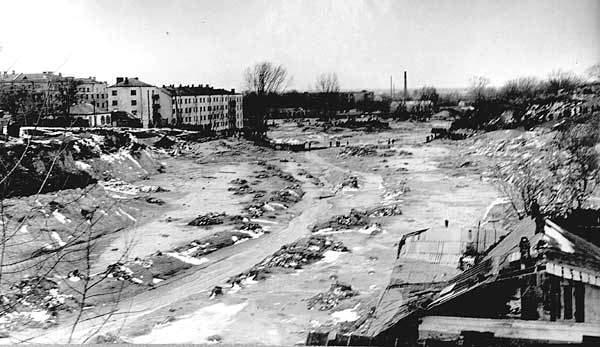
As of 10 pm on March 13 from the area of flooding were evacuated 800 people. and 117 injured. Checked 25 corpses, including 4 men, 19 women and two children. 15 corpses identified. According to a survey of victims it is expected that under the rubble of houses is still part of the corpses. Of the 15 some unidentified recovered from the burned bus, which was traveling from Dymer ... »

How many people died in this nightmare, not known until now. According to the once secret Help №10 «About progress in the aftermath of the flooding in the streets Frunze Podolsky district of Kiev," during the liquidation of the accident were found 133 corpses in hospitals died while 4 people - just 137 people. On the day of the disaster administration tram depot were looking for another 8 persons.
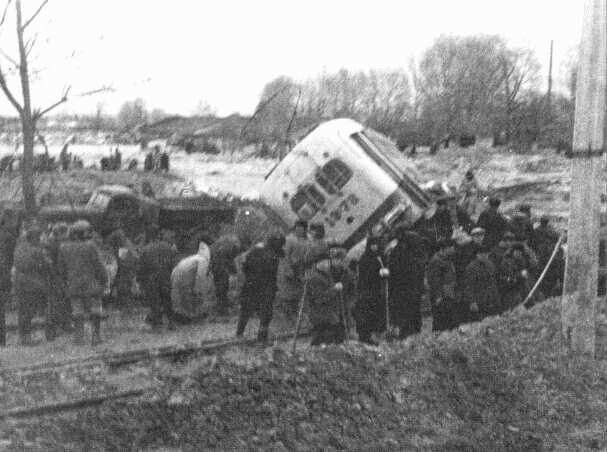
Epilogue
Witnesses who participated in the liquidation of consequences of mudflow, testified that on the excavation of mud skid driven bulldozers, blades that were tearing apart some corpses. Unearth live not try to post in the capital's hospitals, and in the suburbs. And then, where someone died, and there he was buried. And the deaths of the victims in the statistics are not logged in.

In order to avoid politicizing the event at the enterprises were banned civil funeral, the dead were buried in the cemeteries of the city and even in the field. The victims who lost property received a warrant for the apartment, some even issued stamps for the purchase in installments TV and refrigerator.

After the disaster that occurred in the capital of Ukraine on Kurenyovka to Monday, March 13, 1961, aircraft of "Aeroflot" for a few weeks and overflew changed routes is a scary place, so that none of the passengers could not see from the window of the true extent of the tragedy. A few days Kiev was cut off from the world. I did not work long distance, and even more international telephone.
Disaster in the area between st. Frunze and
st. Novokonstantinovskaya
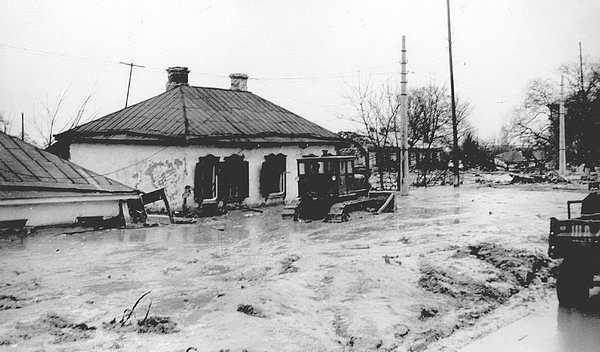
In 1962, at Babi Yar was thrown a huge amount of equipment - excavators, bulldozers, dump trucks, scrapers. The soil was put back into the Yar and partly laid out in place of the deceased district. Babi Yar was still asleep. Through it paved highway. In the capital of a concrete dam planted poplar. These contemporaries of the tragedy alive to this day.
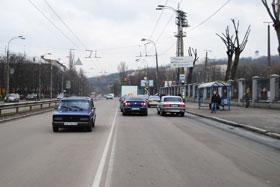
The State Commission was established. In transcripts of its meetings are such revelation: "There was no need to build a frivolous dambochek, and it was necessary to build a dam of capital, which for decades had to be there. No other facilities could not ensure the safety of the city. " "We are not a dam, and a crust that could burst at any time, under the pressure of the liquid masses».
The site of the Babi Yar gidrootvalov below. At the bottom of the slopes and ovraga-
traces of mud flow. View from the Lukyanovka
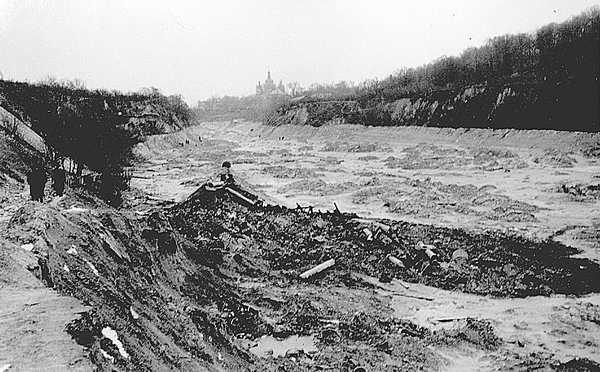
The report of the Special Commission of the USSR State Construction Committee "Protective measures in the area of Babi Yar", prepared in 1962, given a description of the accident: "On the morning of 3/13/1961, the number 3 in the spur of the Babi Yar, overlooking the street. Frunze Podolsky district of Kiev, the accident occurred. It was that part of the dumps gidronamyva by stripping pits Peter's brick factories (out of the total namytyh masses at Babi Yar over 4 million. Cu. M, including the spur of number 3 of about 3, 2 million. Cu. M.) dvizhenie.Razzhizhennaya came in mass, going down the ravine at a rate of 3-5 meters per second brought it part of the residential blocks between the streets Frunze and New Konstantinovskaya area of 30 hectares. The amount of weight, made at the specified area will be on measurements of about 600 thousand. Cu. m.Ostalnaya often move compacting earth mass of approximately 50 thousand. cu. m. was deposited in the area between said gidrootvalami and Frunze Street. The spreading of liquefied ground mass of ukaznoy above area lasted for about 30 minut.Posle destruction of the dam number 1 and removal of the liquefied ground mass for about 2 hours of continued flow of water from the ravine on the street. Frunze ».
View of the ruined hydraulic dump from the street. Frunze

There was a trial, the proceedings of which have long been destroyed. The prison has gone six "scapegoats" :. None of the city officials in the dock sat down. Alexey Davydov died shortly afterwards - there were rumors that he had shot himself. His name is on the boulevard Rusanovka.
The commission's conclusions were kept secret until the 90s. Museum Kurynivska tragedy appeared only
thanks from Kiev Lydia Livinskiy, who worked at the depot in the year of the catastrophe ...
Monument to the Fallen
via mgsupgs LJ

Source:
Within minutes the area (over thirty hectares) proved
a multimeter layer of sand, pellets, mud and clay. Dozens of buildings were destroyed, and the main thing - killed hundreds of people! From fallen power poles lit up a crowded (the notorious rush hour!) Bus, trolley bus, tram. Man-made elements have become hostages of the drivers
trucks, passengers of cars, pedestrians and onlookers just ...
What happened?

1961. Soviet man first flew in space. Kiev scientists headed by Academician Glushko launches the first electronic computer machine in Europe, the predecessor of the modern computer. Kiev "Dinamo" becomes champion of the USSR.
Several thousand families celebrated the housewarming. Kiev is growing strongly. There are new housing estates. In the capital, the construction is in full swing. The country needs a brick. Many brick. The plant operates in three shifts, in order to implement the plan and to bring happiness to the people of Kiev brand new "Khrushchev."

Monday 13th began as an ordinary spring day. Kievans rush to work in time to perform their civic duty and increase the achievements of socialism. "Humpback" buses could hardly cope with the large number of passengers.

Suddenly, a small stream of water paralyzed traffic in the area Kurenivka. Suddenly, a small stream instantly turned into a huge avalanche of gray-brown color. It swept away everything in its path: cars, houses, people. At this point, someone called in a phone booth, and he was killed with a pipe in his hand. Someone just sat down for breakfast, and died for the dinner table. Someone managed to survive in spite of death. Some survivors of the fateful date of March 13 is still pursuing.
Way pulp by St. Cyril's Church

In the area of Babi Yar dam burst, followed by more than 10 years produces hydraulic alluviation with Peter's brick plants. The dam began to break down in the early morning. At 6:45, after 3, 5 o'clock it burst. Mud shaft ran through the streets of the district Kurenivka demolishing buildings, people, corpses and coffins with the remains of the nearby cemetery. Gradually rural dispersed up to 60-70 km / h. The flood lasted only half an hour, but the consequences were disastrous.
Area flooded pulp Kurenevka.
In the foreground - the stadium «Spartak»,
further - building on Frunze Street and the depot Krasin. 1961

Under the blow fell the tram depot. Krasin (nowadays carbs "hem"), the plant "Ukrpromkonstruktor", hospital, stadium "Spartak", part of the street. Frunze, housing and in the ravine below. Due to the short-circuit ignited transport people amazed shock. Several employees of the depot sacrificed their lives, but disconnect the power substation - otherwise the consequences could be even worse.
Kindergarten and homes

The height of the tree in the street Frunze halved, but it was enough to have killed hundreds of people. Rasteksheysya pulp became as hard as stone. Bordering fence with Podolski descent stadium "Spartak" was flooded with a layer of mud and clay so that its high fence was not visible, it was flooded carbs. Building hospitals Podolsk resist. Some of the patients escaped from the flood on its roof.

Where it all began:
The first step to disaster Kiev made March 28, 1950, when the Executive Committee of the Kiev city council made the decision №582.
This decision would approve the design and organization of gidrootvalov spurs in Babi Yar, with the filing of the Ministry of construction materials prepared by the Moscow Trust jetting. But the decision of the executive committee №2405 some changes made: for example, the reclamation has been raised to the very edge of the ravine!

Earlier this place was a sand pit. Work on filling the ravine began in 1952, surrounded by earthen dams space dredge began pumping pulp - with places for the development of Peter clay brick factories. The height of the protective dam was ten meters lower safety standards. But, above all, a former quarry filled at a height of sixty meters above the large residential and industrial district of Kiev ...
Filled pulp headwaters ravine between the current streets Olzhych and Melnikov.
On the left side of the frame - a pumping station (hereinafter - March 1961)

Not very successful project "dobilo" interference of officials amateurs ...
So, the project gidronamyva been "finalized". Underestimated the water content of rocks ravine. It does not take into account the likelihood of a snowy winter. The concrete dam was replaced by zemlyanye.Iz savings to reduce the diameter of drainage pipes, which ultimately did not allow the water to escape, leaving the soil brought. Brick plants, exceeded the plan, working in three shifts -, respectively, and the amount of pulp became three times the estimated income. And to top it all - to alarms went unanswered.

Then, in 1961, in the ravine it has accumulated almost four million cubic meters of liquid slurry Peter's brick plants. In this way the city government, led since 1947 by Alexey Davydov, sought to kill several birds with one stone: to establish smooth, room, industrial production of bricks, so necessary in the construction of numerous residential areas, create a convenient traffic between raw and Kurenyovka (street Olena Teligi) and simultaneously eliminate Babi Yar, breaking in the best Soviet traditions in its place the city recreation park with binding attractions, stadiums and restaurant complex.
The mouth of the debris flow (at the top of the dike scour)

Glushchenko, head of Inspection Podolsk district, reports the February 11, 1957 the head of the Kiev branch of jetting Tsipenyuk and director of the plant Petrovsky brick factories Braz: "due to lack of supervision by your employees, ditch Babi Yar is always in poor condition, especially during the winter. The ditch is filled, and water together with sand overflows its banks and floods the surrounding areas of enterprises and organizations ».
But alarm condition "ditch Babi Yar", no one responded. In early March 1961, concern began to beat Kiev simple: they saw streams flowing on Dams. But the authorities are not troubled until the very moment of the tragedy.
Destroyed lower dam

The tragedy, when suddenly a huge mass of pulp broke through an earthen dam and at a speed of five meters per second at a height of four-storey house rushed down to the Kurenevka, sweeping wave of his all life, hope never happen again. Avalanche wet soil volume of 700 thousand. Cubic meters of width of about 20 meters and a height of about 14 m slid along the ravine and rolled down the street. Frunze, smashing everything in its path. 34 one-, two-storey houses 5, 2 dorm, 12 single-storey houses of the state fund. The total area of these buildings was five thousand square meters, overturned buses and trolley buses, tram depot destroyed them. Krasin, the stadium "Spartak" - is "mining" elements. 25 hectares were under the 3-meter layer of pulp. The exact number of victims is so still and unknown - officially announced the 145 victims. However, according to eyewitnesses, the number of those killed in the crash much more - about 2 thousand.

Damaged pilot plant "Ukrpromkonstruktor" overhauls the Office of City Council, energy management "Kyivenergo", rail welding plant №5 South-Western Railway. That's nearly 9, 000 square meters. The total area flooded pulp amounted to more than 30, 000 square meters.

This tragedy has destroyed seven tram, trolleybus and bus passengers, three enterprises of the region, has killed hundreds of people of Kiev - as the employees of these companies, and passengers who were traveling to work in other areas, residents of dormitories, a large private sector, military and firefighters, policemen doctors, patients clinic №15, drivers and passengers of vehicles - we know of two nonfiction books and memoirs of eyewitnesses.

They say the archives
"... In 8 hours 30 minutes in the morning in a good effort levee, which was built for the production of zamyva Babi Yar, water and soil liquefaction was flooded part of the territory adjacent to the street to them. Frunze near the tram depot. By 10 am the flow of water has stopped. As a result of the flooding destroyed 68 residential and 13 office and industrial buildings. Given in disrepair 298 residential apartments, including 163 in private households, inhabited by 353 families with a total of 1228 people ...

As of 10 pm on March 13 from the area of flooding were evacuated 800 people. and 117 injured. Checked 25 corpses, including 4 men, 19 women and two children. 15 corpses identified. According to a survey of victims it is expected that under the rubble of houses is still part of the corpses. Of the 15 some unidentified recovered from the burned bus, which was traveling from Dymer ... »

How many people died in this nightmare, not known until now. According to the once secret Help №10 «About progress in the aftermath of the flooding in the streets Frunze Podolsky district of Kiev," during the liquidation of the accident were found 133 corpses in hospitals died while 4 people - just 137 people. On the day of the disaster administration tram depot were looking for another 8 persons.

Epilogue
Witnesses who participated in the liquidation of consequences of mudflow, testified that on the excavation of mud skid driven bulldozers, blades that were tearing apart some corpses. Unearth live not try to post in the capital's hospitals, and in the suburbs. And then, where someone died, and there he was buried. And the deaths of the victims in the statistics are not logged in.

In order to avoid politicizing the event at the enterprises were banned civil funeral, the dead were buried in the cemeteries of the city and even in the field. The victims who lost property received a warrant for the apartment, some even issued stamps for the purchase in installments TV and refrigerator.

After the disaster that occurred in the capital of Ukraine on Kurenyovka to Monday, March 13, 1961, aircraft of "Aeroflot" for a few weeks and overflew changed routes is a scary place, so that none of the passengers could not see from the window of the true extent of the tragedy. A few days Kiev was cut off from the world. I did not work long distance, and even more international telephone.
Disaster in the area between st. Frunze and
st. Novokonstantinovskaya

In 1962, at Babi Yar was thrown a huge amount of equipment - excavators, bulldozers, dump trucks, scrapers. The soil was put back into the Yar and partly laid out in place of the deceased district. Babi Yar was still asleep. Through it paved highway. In the capital of a concrete dam planted poplar. These contemporaries of the tragedy alive to this day.

The State Commission was established. In transcripts of its meetings are such revelation: "There was no need to build a frivolous dambochek, and it was necessary to build a dam of capital, which for decades had to be there. No other facilities could not ensure the safety of the city. " "We are not a dam, and a crust that could burst at any time, under the pressure of the liquid masses».
The site of the Babi Yar gidrootvalov below. At the bottom of the slopes and ovraga-
traces of mud flow. View from the Lukyanovka

The report of the Special Commission of the USSR State Construction Committee "Protective measures in the area of Babi Yar", prepared in 1962, given a description of the accident: "On the morning of 3/13/1961, the number 3 in the spur of the Babi Yar, overlooking the street. Frunze Podolsky district of Kiev, the accident occurred. It was that part of the dumps gidronamyva by stripping pits Peter's brick factories (out of the total namytyh masses at Babi Yar over 4 million. Cu. M, including the spur of number 3 of about 3, 2 million. Cu. M.) dvizhenie.Razzhizhennaya came in mass, going down the ravine at a rate of 3-5 meters per second brought it part of the residential blocks between the streets Frunze and New Konstantinovskaya area of 30 hectares. The amount of weight, made at the specified area will be on measurements of about 600 thousand. Cu. m.Ostalnaya often move compacting earth mass of approximately 50 thousand. cu. m. was deposited in the area between said gidrootvalami and Frunze Street. The spreading of liquefied ground mass of ukaznoy above area lasted for about 30 minut.Posle destruction of the dam number 1 and removal of the liquefied ground mass for about 2 hours of continued flow of water from the ravine on the street. Frunze ».
View of the ruined hydraulic dump from the street. Frunze

There was a trial, the proceedings of which have long been destroyed. The prison has gone six "scapegoats" :. None of the city officials in the dock sat down. Alexey Davydov died shortly afterwards - there were rumors that he had shot himself. His name is on the boulevard Rusanovka.
The commission's conclusions were kept secret until the 90s. Museum Kurynivska tragedy appeared only
thanks from Kiev Lydia Livinskiy, who worked at the depot in the year of the catastrophe ...
Monument to the Fallen
via mgsupgs LJ

Source:
Tags
See also
50 amazing facts about the Earth
50 facts about the Earth
In China, it does not stop the abnormal geological phenomena
Feelings and emotions — pointers on the way
Panama Canal
Man-made disasters of the XXI century
What is quicksand (3 photos)
Tragedy in China (67 photos)
Few tolerastov of purebred Swedish women

















